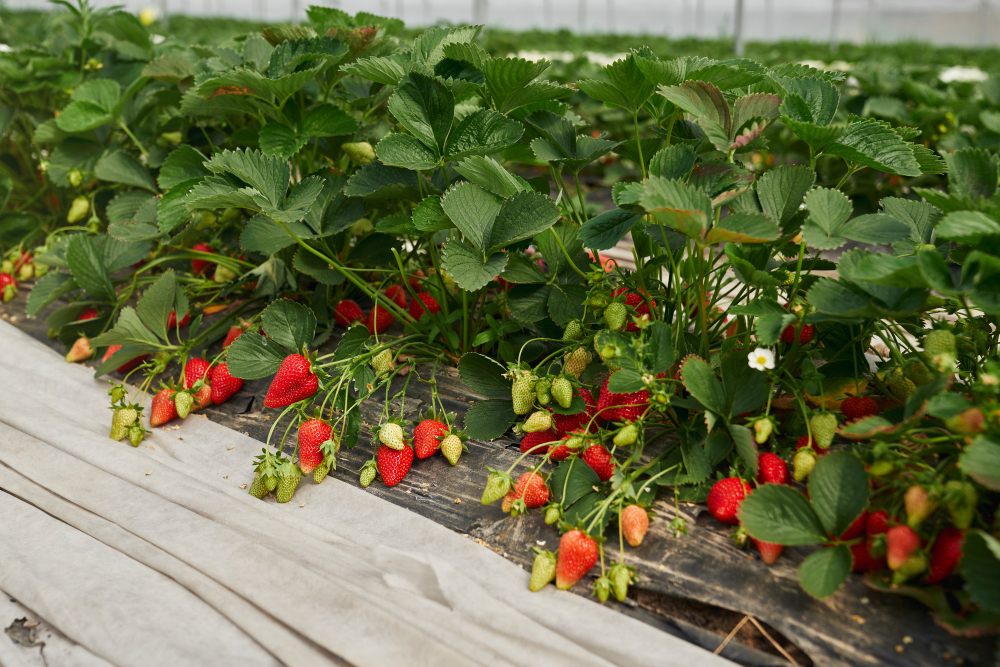Strawberries, those sweet and juicy summer delights, are a favorite among gardeners. However, a successful harvest of this beloved fruit requires keeping the plants in prime health. One common issue that strawberry growers encounter is the browning of plant leaves, a symptom that can be quite disconcerting.
This article aims to demystify the causes behind this phenomenon, identify its symptoms, and provide effective treatments. Consider this your comprehensive guide to understanding and tackling the problem of brown leaves on strawberry plants, helping you to ensure a healthy strawberry plant appearance and a fruitful yield every season. Read on to learn more!
Strawberry Plant Leaves Turning Brown: Causes And Symptoms
There are several reasons why the leaves of strawberry plants may turn brown, each suggesting a different issue with the plant’s health. Some common causes include the following:
Fungal diseases
Fungal diseases, such as leaf spot (Mycosphaerella fragariae) and botrytis (Botrytis cinerea), are common culprits behind the browning of strawberry plant leaves. Leaf spot is an infection that begins as small purple spots on the leaf surface, which eventually turn brown and may coalesce into larger blotches. This disease can also affect the fruit, leading to less bountiful harvests.
Botrytis, also known as grey mold, causes a similar browning effect on the leaves but is also notable for the fuzzy grey growth that may appear on the fruit and flowers. Both of these fungal diseases thrive in damp, cool conditions and can spread quickly between plants if not promptly addressed.
Pest infestations
Spider mites and aphids are two common pests that can lead to the browning of strawberry plant leaves. Spider mites, minuscule arachnids often invisible to the naked eye, feed on plant sap, causing stippling (small, dotted discoloration) on the leaves, which can eventually turn the whole leaf brown if the infestation is severe. Aphids, tiny insects that also feed on plant sap, can cause similar damage. These pests are not only a threat due to their feeding habits but also because they can transmit viruses that can further harm the plant.
Overwatering or poor drainage
Overwatering strawberry plants or planting them in poorly draining soil can also lead to leaf browning. This is largely because strawberries, like many plants, require a delicate balance of moisture. Soil that is perpetually soaked can lead to root suffocation and decay, a condition commonly known as root rot. When the roots are diseased or damaged, they cannot adequately absorb nutrients and water, leading to overall plant stress and the browning of leaves.
Poor drainage also creates an environment conducive to the development of certain diseases. Waterlogged soil can promote the growth and spread of harmful fungi, bacteria, and pests, which can contribute to leaf discoloration.
Nutrient deficiencies or imbalances
Strawberries, like all plants, require a specific balance of nutrients to thrive. A lack of essential minerals or an imbalance of these nutrients can cause leaf browning and other symptoms of poor plant health. For instance, a nitrogen deficiency often manifests as yellowing and wilting of leaves with brown edges. Similarly, potassium deficiencies can lead to necrosis (tissue death) on the edges and tips of leaves, giving them a scorched appearance that may eventually spread throughout the leaf.
Environmental stressors like extreme heat or cold
Extreme temperatures, whether hot or cold, can also cause leaf browning in strawberry plants. When exposed to prolonged periods of high heat, the leaves may become scorched and dried out, turning brown and brittle. On the other hand, exposure to frost or freezing temperatures can damage the plant’s cell walls and lead to discoloration, often beginning at the edges of leaves.
Some plants may also experience “sunscald,” a condition in which the leaves become brown or white spots due to intense exposure to sunlight. Especially with perennial strawberries, leaves that were previously green may turn brown as they age and naturally die off.
How To Treat Strawberry Plant Leaves Turning Brown
Now that you know the potential causes of browning leaves on strawberry plants, explore some effective treatments to restore your plant’s health and prevent future problems. Here are a few measures you can take:
Pruning affected leaves and branches
Pruning is an essential practice for managing the health of your strawberry plants. It involves removing affected leaves and branches to prevent the spread of diseases and pests. Start by carefully cutting off any brown or diseased leaves at their base, ensuring to use clean, sharp shears to avoid causing further damage or spreading pathogens.
Pruning in this way not only helps to curb the spread of the problem to the rest of the plant but also improves air circulation. This, in turn, reduces the humidity around the plant, a condition favorable to many pests and diseases. After pruning, dispose of the removed plant parts responsibly, ideally by burning or disposing of them in a sealed bag. Do not compost them as this may spread diseases. Regularly inspect your plants, especially during the growing season, and prune as necessary to keep them healthy.
Applying fungicides or natural remedies for fungal diseases
For fungal diseases, both chemical fungicides and natural remedies can be effective. If you choose to use a fungicide, always follow the manufacturer’s instructions carefully. Some recommended fungicides for diseases like leaf spot and botrytis include captan and chlorothalonil, which are typically applied as a spray to both sides of the leaves and may need repeated applications over the season.
On the other hand, if you prefer a more organic approach, consider natural antifungal treatments. For instance, a mixture of baking soda and water can work as a homemade fungicide. A typical recipe involves mixing one tablespoon of baking soda and half a teaspoon of liquid soap with one gallon of water. Spray this mixture onto the affected plants every few days until the fungus is under control.
Neem oil is another natural option that can effectively tackle fungal diseases. Besides its fungicidal properties, neem oil also acts as an insecticide, offering comprehensive protection for your plants. A mixture of two tablespoons of neem oil and one gallon of water can be sprayed on the plants every one to two weeks.
Garlic extract is also known for its antifungal properties. A homemade garlic spray can be made by blending two whole bulbs (not just two cloves) with a small amount of water, then steeping the mixture overnight before straining it into a jar, filling it to the top with water, and adding a few drops of eco-friendly dish soap.
Implementing pest control measures
Several measures can be implemented to control pests like spider mites and aphids that can cause the leaves of strawberry plants to turn brown.
Using insecticidal soaps or oils
Insecticidal soaps or horticultural oils can be effective in controlling small, soft-bodied arthropods such as aphids and spider mites. These solutions work by suffocating the pests or disrupting their feeding and are typically sprayed directly onto the plant. They are considered safer options because they don’t leave a long-lasting residue and are less harmful to beneficial insects and the environment.
Introducing beneficial insects
Introducing beneficial insects into your garden can be a natural and effective way to control pest populations. For example, ladybugs and lacewings are natural predators of aphids, while predatory mites can help control spider mite infestations.
Implementing physical barriers
Physical barriers, such as row covers or netting, can provide a degree of protection against larger pests. Additionally, using mulch around your plants can deter certain pests and also help maintain appropriate moisture levels.
Rotational planting and good sanitation practices
Rotational planting can prevent the buildup of pests by disrupting their life cycles. Additionally, good sanitation practices, such as removing dead or diseased plant material and regularly cleaning tools and containers, can minimize the spread of pests.
Adjusting watering and drainage practices
Adjusting watering and drainage practices can significantly help in controlling the browning of strawberry plant leaves. Strawberries prefer well-drained soil and do not tolerate waterlogging. Thus, if overwatering or poor drainage is the cause of your plant’s browning leaves, consider taking steps to correct the situation.
Improving Drainage
If your soil drains poorly, amending it with organic matter, such as compost or well-rotted manure, can improve its structure and enhance drainage. Raised beds or planting in containers can also provide better drainage and prevent waterlogging. When planting in containers, ensure they have adequate drainage holes.
Watering Practices
When watering strawberry plants, they generally need about one inch of water per week, either from rainfall or irrigation. Monitor the weather and adjust your watering schedule accordingly. Water deeply to reach the roots but do so less frequently to encourage the plants to develop deep root systems.
Avoiding Overwatering
Avoid overwatering as it can lead to root rot, fungal diseases, and, subsequently, browning leaves. A good way to check if your plants need watering is to feel the soil a few inches below the surface – if it feels dry, it’s time to water.
Correcting nutrient issues with fertilization
When faced with nutrient deficiencies or imbalances, fertilization can be an effective solution. Before adding any fertilizers, it’s essential to test your soil to determine its nutrient levels and pH.
Depending on the specific deficiency or imbalance identified, you may need to apply a balanced fertilizer that contains equal amounts of nitrogen, phosphorus, and potassium (N-P-K). Alternatively, some gardeners prefer using organic options like compost or fish emulsion. Whatever method you choose, remember to apply fertilizers sparingly and in accordance with the instructions provided.
Protecting plants from extreme weather conditions
Finally, protecting plants from extreme weather conditions can help prevent leaf browning. For instance, during hot periods, consider providing temporary shade using fabric covers or planting in areas with partial sun exposure. When frost is a concern, use row covers or plastic tunnels to protect the plants. Additionally, watering regularly and adjusting watering practices as needed can also help mitigate the effects of extreme temperatures.
Bottom Line
Strawberry plant leaves turning brown can indicate a wide range of issues, from fungal diseases and pest infestations to environmental stressors and nutrient deficiencies. Understanding the underlying cause is key to effectively treating and preventing recurring problems. By implementing some of the measures discussed above, you can help keep your strawberry plants healthy and vibrant, ensuring a bountiful harvest of delicious berries season after season. So don’t wait until your plants are in distress – be proactive in caring for them with proper pruning, watering, fertilization, and pest control practices. Happy gardening!




